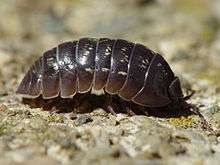Armadillidiidae
| Armadillidiidae | |
|---|---|
 | |
 | |
| Armadillidium vulgare walking (above) and in defensive posture (below) | |
| Scientific classification | |
| Kingdom: | Animalia |
| Phylum: | Arthropoda |
| Subphylum: | Crustacea |
| Class: | Malacostraca |
| Order: | Isopoda |
| Suborder: | Oniscidea |
| Family: | Armadillidiidae Brandt, 1833 |
Armadillidiida is a family of woodlice, a terrestrial crustacean group in the order Isopoda. Unlike members of other woodlouse families, members of this family can roll into a ball, an ability they share with the outwardly similar but unrelated pill millipedes and other animals. It is this ability which gives woodlice in this family their common names of pill bugs,[1] roly polies, or doodle bugs.[2] The best known species in the family is Armadillidium vulgare, the common pill bug.
Ecology and behaviour
Pill bugs in the family Armadillidiidae are able to form their bodies into a ball shape, in a process known as conglobation. This behaviour is shared with pill millipedes (which are often confused with pill bugs[3]), armadillos and cuckoo wasps.[4] It may be triggered by stimuli such as vibrations or pressure, and is a key defence against predation; it may also reduce respiratory water losses.[5]
Classification
The family Armadillidiidae is differentiated from other woodlouse families by the two-segmented nature of the antennal flagellum, by the form of the uropods, and by the ability to roll into a ball, or conglobate.[6]
Within the family Armadillididae, fifteen genera are currently recognised:[7]
- Alloschizidium
- Armadillidium
- Ballodillium
- Cristarmadillidium
- Cyphodillidium
- Echinarmadillidium
- Eleoniscus
- Eluma
- Paraschizidium
- Paxodillidium
- Platanosphaera
- Schizidium
- Trichodillidium
- Troglarmadillidium
- Typhlarmadillidium
References
- ↑ Gordon Gordh & David H. Headrick (2011). "Common pillbug". A Dictionary of Entomology (2nd ed.). CAB International. p. 343. ISBN 9781845935429.
- ↑ Kenn Kaufman & Kimberly Kaufman (2012). Kaufman Field Guide to Nature of New England. Houghton Mifflin Harcourt. p. 364. ISBN 9780618456970.
- ↑ "Pill millipede (Glomeris marginata)". ARKive. Retrieved June 21, 2007.
- ↑ Edward M. Barr (2001). Animal behavior desk reference: a dictionary of animal behavior, ecology, and evolution (2nd ed.). CRC Press. p. 142. ISBN 978-0-8493-2005-7.
- ↑ Jacob T. Smigel & Allen G. Gibbs (2008). "Conglobation in the pill bug, Armadillidium vulgare, as a water conservation mechanism" (PDF). Journal of Insect Science 8 (44): 1–9. doi:10.1673/031.008.4401. PMC 3127403. PMID 20233103.
- ↑ P. J. Hayward & John Stanley Ryland (1995). "Crustaceans". Handbook of the marine fauna of north-west Europe. Oxford University Press. pp. 289–461. ISBN 978-0-19-854055-7.
- ↑ Marilyn Schotte (2012). M. Schotte, C. B. Boyko, N. L. Bruce, G. C. B. Poore, S. Taiti & G. D. F. Wilson, ed. "Armadillidiidae". World Marine, Freshwater and Terrestrial Isopod Crustaceans database. World Register of Marine Species. Retrieved September 26, 2012.
External links
 Data related to Armadillidiidae at Wikispecies
Data related to Armadillidiidae at Wikispecies- Regional maps for the most common American names for this isopod can be found in the results for question 74 of the Harvard Dialect Survey.